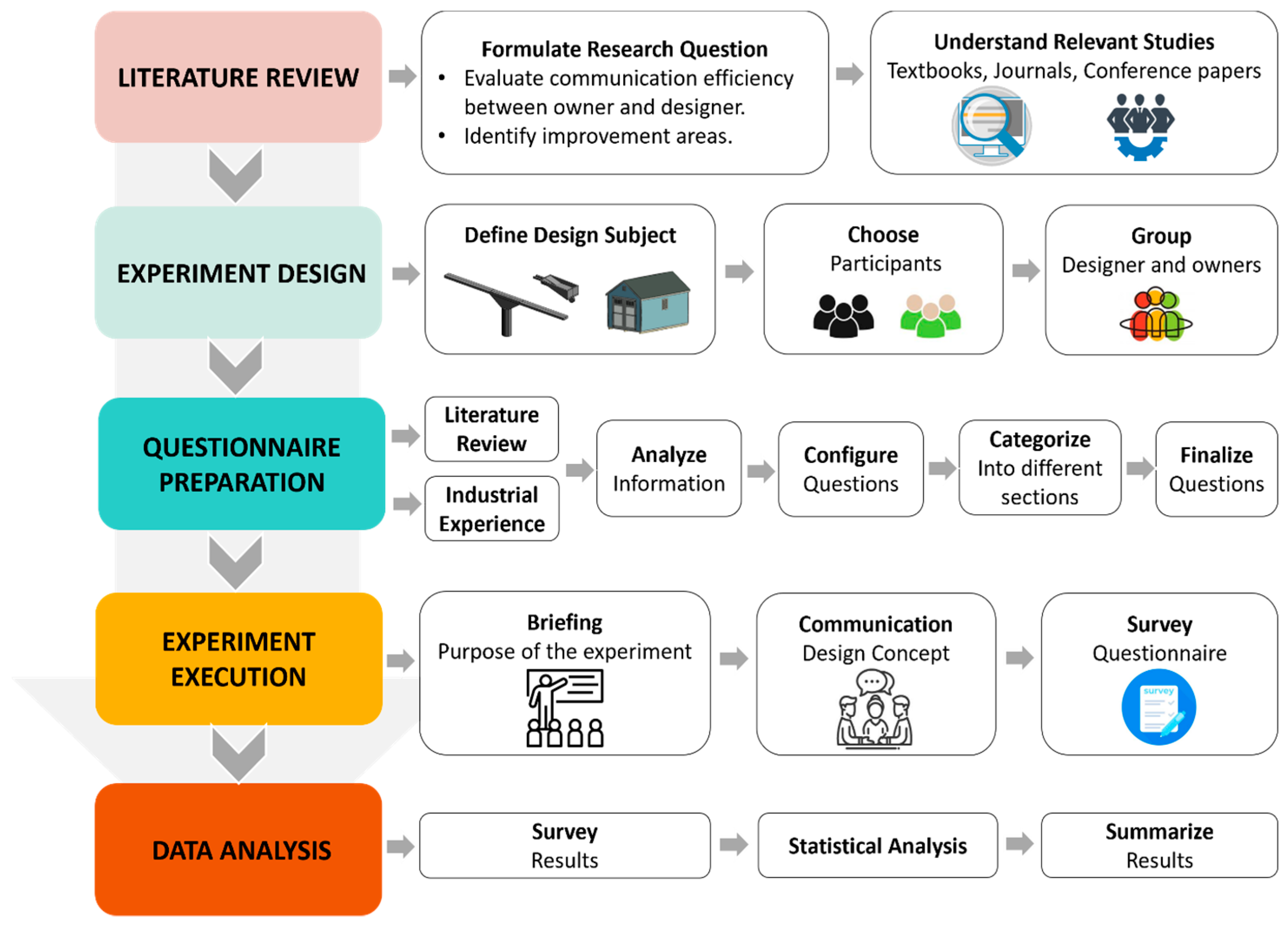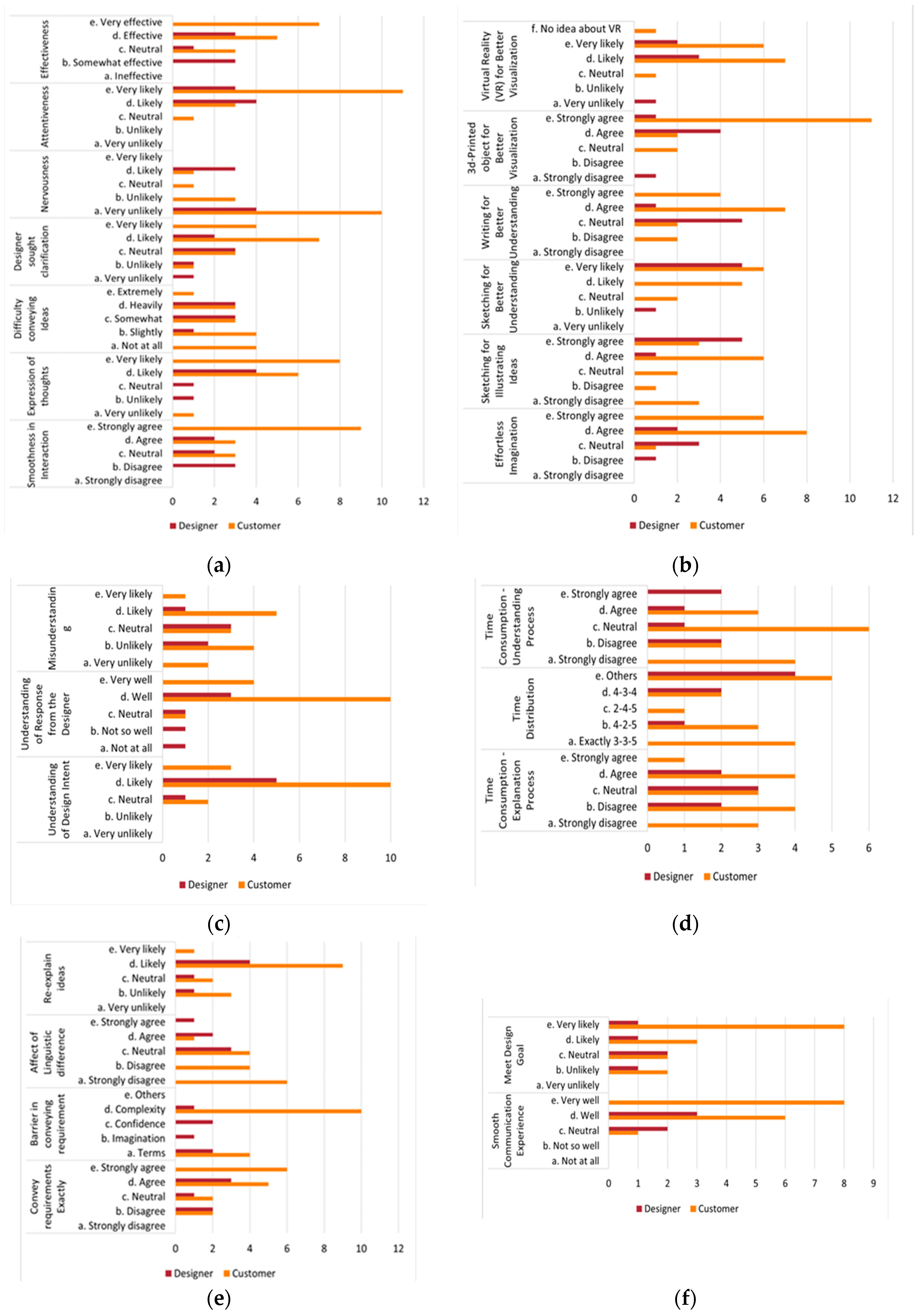Exploring Miscommunications in the Construction Industry Through Experiments †
Abstract
1. Introduction
2. Materials and Methods
3. Results and Discussion
3.1. Interaction
3.2. Visualization
3.3. Understanding
3.4. Time
3.5. Accuracy
3.6. Satisfaction
4. Conclusions
Author Contributions
Funding
Institutional Review Board Statement
Informed Consent Statement
Data Availability Statement
Conflicts of Interest
References
- Akintelu, S.O.; Oyebola, A.I.; Tiamiyu, S.; Olateju, O. The impact of project communication management on successful project delivery in the construction industry: A case study. Int. J. Dev. Sustain. 2023, 12, 376–386. [Google Scholar]
- Tran, D.Q.; Nguyen, L.D.; Faught, A. Examination of communication processes in design-build project delivery in building construction. Eng. Constr. Archit. Manag. 2017, 24, 1319–1336. [Google Scholar] [CrossRef]
- Kamalirad, S.; Kermanshachi, S.; Shane, J.; Anderson, S. Assessment of construction projects’ impact on internal communication of primary stakeholders in complex projects. In Proceedings of the 6th CSCE-CRC International Construction Specialty Conference 2017, Vancouver, BC, Canada, 31 May–3 June 2017. [Google Scholar]
- Oluwatayo, A.A.; Ibem, E.; Amole, D. Satisfaction of first-time residential clients with architectural services. J. Eng. Des. Technol. 2014, 12, 316–335. [Google Scholar]
- Galaz-Delgado, E.I.; Herrera, R.F.; Atencio, E.; Muñoz-La Rivera, F.; Biotto, C.N. Problems and challenges in the interactions of design teams of construction projects: A Bibliometric Study. Buildings 2021, 11, 461. [Google Scholar] [CrossRef]
- Norouzi, N.; Shabak, M.; Embi, M.R.B.; Khan, T.H. The architect, the client and effective communication in architectural design practice. Procedia-Soc. Behav. Sci. 2015, 172, 635–642. [Google Scholar] [CrossRef]
- Carraher, E.; Smith, R.E. Leading Collaborative Architectural Practice, 1st ed.; John Wiley & Sons: Hoboken, NJ, USA, 2017. [Google Scholar]
- Gad, G.; Cho, J.; Lomiento, G. Fostering Disciplines’ Understanding among Design and Construction Students through a Design-Build Senior Project. In Proceedings of the ASEE Annual Conference and Exposition, Columbus, OH, USA, 25–28 June 2017. [Google Scholar]
- Mertens, A.; Hamarat, Y.; Elsen, C. Interactions between architects and end-users during housing design processes: A systematic literature review. Archnet-IJAR 2023, 17, 703–724. [Google Scholar] [CrossRef]
- Abdallah, A.; Shaawat, M.; Almohassen, A.S. Causes of miscommunication leading to project delays and low work quality in the construction industry of Saudi Arabia. Ain Shams Eng. J. 2024, 15, 102447. [Google Scholar] [CrossRef]
- Thomas, S.R.; Tucker, R.L.; Kelly, W.R. Critical communications variables. J. Constr. Eng. Manag. 1998, 124, 58–66. [Google Scholar] [CrossRef]
- Luck, R.; McDonnell, J. Architect and user interaction: The spoken representation of form and functional meaning in early design conversations. Des. Stud. 2006, 27, 141–166. [Google Scholar] [CrossRef]
- Rahman, I.A.; Gamil, Y. Assessment of cause and effect factors of poor communication in construction Industry. IOP Conf. Series. Mater. Sci. Eng. 2019, 601, 012014. [Google Scholar] [CrossRef]
- Norouzi, N.; Shabak, M.; Embi, M.R.B.; Khan, T.H. A new insight into design approach with focus to architect-client relationship. Asian Soc. Sci. 2015, 11, 108–120. [Google Scholar] [CrossRef]
- Prieto, A.; Armijos-Moya, T.; Konstantinou, T. Renovation process challenges and barriers: Addressing the communication and coordination bottlenecks in the zero-energy building renovation workflow in European residential buildings. Archit. Sci. Rev. 2024, 67, 205–217. [Google Scholar] [CrossRef]
- Tariq, J.; Gardezi, S. Study the delays and conflicts for construction projects and their mutual relationship: A review. Ain Shams Eng. J. 2022, 14, 101815. [Google Scholar] [CrossRef]
- Bogers, T.; van Meel, J.J.; van der Voordt, T.J.M. Architects about briefing: Recommendations to improve communication between clients and architects. Facilities 2008, 26, 109–116. [Google Scholar] [CrossRef]
- Doloi, H.; Sawhney, A.; Iyer, K.C.; Rentala, S. Analysing factors affecting delays in Indian construction projects. Int. J. Proj. Manag. 2012, 30, 479–489. [Google Scholar] [CrossRef]


Disclaimer/Publisher’s Note: The statements, opinions and data contained in all publications are solely those of the individual author(s) and contributor(s) and not of MDPI and/or the editor(s). MDPI and/or the editor(s) disclaim responsibility for any injury to people or property resulting from any ideas, methods, instructions or products referred to in the content. |
© 2025 by the authors. Licensee MDPI, Basel, Switzerland. This article is an open access article distributed under the terms and conditions of the Creative Commons Attribution (CC BY) license (https://creativecommons.org/licenses/by/4.0/).
Share and Cite
Koirala, S.; Wang, E.; Ackerman, A.; Lee, S. Exploring Miscommunications in the Construction Industry Through Experiments. Eng. Proc. 2025, 91, 6. https://doi.org/10.3390/engproc2025091006
Koirala S, Wang E, Ackerman A, Lee S. Exploring Miscommunications in the Construction Industry Through Experiments. Engineering Proceedings. 2025; 91(1):6. https://doi.org/10.3390/engproc2025091006
Chicago/Turabian StyleKoirala, Shreya, Endong Wang, Aidan Ackerman, and Seyeon Lee. 2025. "Exploring Miscommunications in the Construction Industry Through Experiments" Engineering Proceedings 91, no. 1: 6. https://doi.org/10.3390/engproc2025091006
APA StyleKoirala, S., Wang, E., Ackerman, A., & Lee, S. (2025). Exploring Miscommunications in the Construction Industry Through Experiments. Engineering Proceedings, 91(1), 6. https://doi.org/10.3390/engproc2025091006





